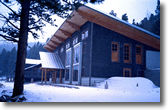- Physical
Setting & Climate lecture handout (color: pdf)
- Lecture-related
notes: Four sources of winter
precipitation (ppt) in the Colorado Front Range:
1) Mid-latitude cyclonic storms arriving from the West, with Warm Front/Cold Front structure
2) Orographic ppt on the Westerlies, spilling over the Divide - favors higher elevations, especially near Divide, little ppt below Pk-to-Pk hwy. Also favors wind loading from the N/NW.
3) Upslope ppt from a "Four-Corners' Low" - usually has high ppt amounts pulling 'warm' moist air from south, similar with elevation on East Slope or even greater in Boulder. Larger flakes.
4) "Arctic Blast" - small amounts ppt because very cold, 'dry' air; starts out as shallow air layer, pushing up Front Range canyons. Small flakes. Often more ppt favored at lower elevations, depends on depth and moisture of Arctic air.
Notes:
- (3) and (4) are also orographically-induced (as 2), just that flow is from East. Cyclonic storms (in 1) are orographically-enhanced, but primary mechanism is the storm's cold front/warm front circulation.
- Cyclonic storms are also enhanced as in (3) by circulation of warm, moist air from south - difference is that in (3) the storm itself is too far to the south, not overhead as in (1).
- In summer, can add 5th
& 6th precipitation mechanisms with (5) local
convection developing along the Divide (with
moisture drawn up from the Plains) and (6)
monsoonal flow from the S and SW into the
continent center, and interacting with the
mountains
- How do global, continental, regional, local position determine climate?
- What are the main mechanisms that
generate wintertime precipitation in the Colorado
Rockies (see above)?
- What are the main processes that determine surface temperature (of the air, of the surface of a tree/mammal)?
Resources
The leeward edge of an extensive mass of orographic clouds may be quite distinct. On the leeward side of the mountain, the air flowing downward is known as a foehn wind. Because some of the moisture has condensed on the top of the mountain, the foehn (or föhn) is drier, so any suspended moisture quickly evaporates as the air descends.
 Winter Ecology
Winter Ecology